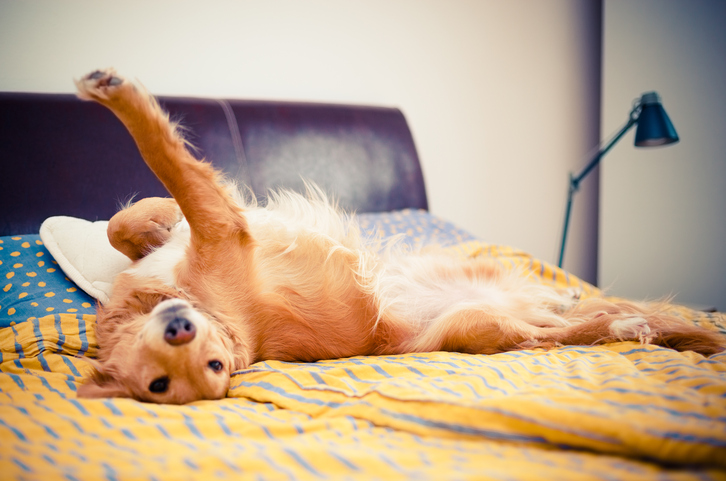As you may have guessed from our latest ad “Somebody to Love” we truly believe that a pet makes a house a home. Because our pets are so important to us ensuring they are safe is crucial. We reached out to our friends at HomeAdvisor to see if they had any tips to do so and as usual they came through with paw-sitively awesome advice.
When pet-proofing one’s home and yard, it is important to look at items from a pet’s standpoint and consider what things they are likely to play with, chew, or otherwise get into. If these items can hurt or even kill, then they should be removed or relocated into an area that the animal cannot access. Pet-proofing a home can take time and even some research so that it is done properly. Pet owners should also take into consideration the damage that a pet can cause to their personal belongings and take steps to prevent that as well. Ideally, pet-proofing should occur before bringing a new pet home; however, it can be done during a home improvement project or at any given time.
Bathrooms and Laundry Rooms
Toilet bowls are filled with water and often tempt pets to drink from them. This can cause a pet to drown, or it may poison them if toilet bowl cleaners are inside. The bathrooms and laundry room of a home are filled with a number of other items that are toxic to pets. Medications, both prescription and otherwise, are often kept in a bathroom, as are things such as bathroom cleaners, chemical drain openers, and deodorizers. Sharp items such as razors are also kept in bathrooms and can cut and seriously injure a pet that plays with or swallows them.
Laundry rooms are also a place where chemicals such as bleach and detergent are stored and regularly used. Fabric softener sheets may seem harmless; however, they are often impregnated with chemicals. Open dryers are tempting to pets that may climb inside to sleep, stay warm, or hide. This can be dangerous if the door is accidentally shut and the machine turned on.
- Place any medications into a medicine cabinet and keep it closed.
- Close the doors to the washing machine and dryer when not in use.
- Check inside the washing machine and dryer before starting, particularly if it was left open and unattended.
- Store laundry and bathroom cleaners and other chemicals inside of a cabinet. If a pet can nudge open a cabinet, use child locks or higher cabinets.
- Close the lid to the toilet when not in use.
Living Rooms
In the living room, there are numerous items that are a threat to one’s pet. Unstable or top-heavy furniture can fall if jumped on or if bumped hard by a playful animal. Many types of potted house plants are known to be toxic if chewed or swallowed. The cords to drapery and window blinds are a choking hazard if they accidental loop around a pet’s neck, while electrical cords, if chewed on, can shock or electrocute one’s pet or start a fire.

Certain items need to be protected so that pets do not damage or knock them over. Candles, for example, can either catch a pet’s tail on fire or may be knocked over and start a fire. Furniture and toys must also be protected, as they risk damage from chewing and scratching or they may cause a pet to choke. Certain items that contain batteries can be swallowed and will poison a pet or cause internal burns.
- Move or cover cords and electrical wires so that they are not easily reached or cannot be chewed on.
- Never leave candles unattended.
- Place a fire screen in front of fireplaces that are in use.
- Keep a toy chest for children’s toys and put them away when they are not being played with.
- Properly dispose of old batteries and keep all others in a closed drawer or cabinet.
- Check what plants are and are not poisonous to the type of pet in the home. Only purchase plants that are not toxic.
Kitchens
Kitchens are an overall dangerous place for pets to be. Jumping pets have access to countertops and tables, while all animals can easily get to anything that’s within their reach, such as kitchen trash cans or food on the table. When it comes to threats, food is the most obvious culprit, as certain items, such as chocolate and raisins, are toxic while others represent a choking hazard.
Kitchen cleaners such as liquid soap and bleach are also poisonous. Curious animals may crawl into a small space under and around the refrigerator or oven, while others may actual climb into an opened dishwasher and could be trapped within if someone closes it without checking it.
- Only use garbage cans with secure lids, and ensure that they are closed at all times.
- Keep cleansers locked away in a cabinet with childproof locks.
- Block access to small spaces that lead behind the refrigerator or other appliances.
- Put food in covered containers instead of leaving it exposed on a counter or table.
- Keep utensils in a closed drawer, and push breakable china back on counters where it cannot easily be knocked down and broken.
- Consider installing a safety gate to keep pets out of the kitchen while cooking.
Bedrooms
Although the bedroom may seem like an overall safe place for pets, it is the unexpected, little things that can prove problematic for pets. Electrical cords are dangerous to pets that are chewers, and small items such as earrings and hair pins may also be chewed or swallowed. Discarded shopping bags are a suffocation risk if a pet sticks its head inside and is unable to shake it off. Moth balls in closets or drawers are toxic, as are certain house plants that may be kept in the room.

- Keep windows closed, particularly on the upper floors, to prevent pets from falling out.
- Check that all windows have screens that are secure and in good condition.
- Place mothballs in a location where they cannot be reached. If there are cats, keep the mothballs in a container.
- Use containers or jewelry boxes to store jewelry or hair pins.
- Cover cords or keep them out of reach.
- Check closets and drawers before closing them to ensure that kittens or other small pets are not hiding inside.
Garages and Basements
Garages and basements are two areas where a pet will likely spend the least time. Unfortunately, they are both areas that are highly dangerous no matter how much time a pet spends there. Because these are areas outside of the main house and protected from the elements outdoors, they are places where deadly chemicals and other potentially lethal items are stored.
Toxic items that are commonly stored in garages and even basements include antifreeze, which is sweet-tasting but can cause a cat or a dog’s kidneys to fail if consumed. Motor oil, gas, battery acid, and car wax are just a few other dangerous car-related items. Additionally, pesticides, rat poison, paint, and paint thinners are examples of items kept in either location that can be lethal to a pet. Sharp and small items can cause injuries if stepped on or if swallowed, and even machinery, including one’s car, can be lethal.
- Store screws and nuts in jars with lids.
- Install cabinets to store chemicals, and keep them closed when not in use.
- Verify the safety of any plants kept in the room.
- Regularly check the floor of the garage for spilled or leaked antifreeze. Clean thoroughly as soon as possible.
- Always check for cats or kittens in the car engine by banging on the hood prior to starting the car.
- Unplug electrical tools and store them where they can’t fall.
Yard
Often, pets such as dogs and even cats like to go outdoors for a little playtime or to bask in the sun. Nature, however, represents numerous threats to pets as they spend time in the yard. Gardens, weeds, and other naturally occurring plants and flowers can all seem appealing to a cat, dog, or other outdoor-venturing pet.

Certain items that are used on the lawn, flowers, and plants, such as fertilizers, pesticides, mulch, and compost, may contain chemicals or elements that a pet should not eat, drink, or lick. Cocoa mulch, for example, is toxic, yet the smell is tempting to animals, and compost may contain food items that pets can choke on or that is toxic to them. Care must be taken to also protect pets in yards with fire pits or outdoor fireplaces, pools, and ponds.
- Install a fence around the yard to keep stray animals out and pets in.
- Remove poisonous plants from the yard, and check with a knowledgeable nursery before planting anything new.
- Put a barrier around gardens to keep pets out.
- Never leave pets alone when a fire pit is in use.
- Add fencing around pools to keep unaccompanied pets away.
- Use an enclosed shed to store chemicals, or keep them in a cabinet in the garage.
- Consider creating a fenced-off area specifically for a dog to play in when outdoors.






